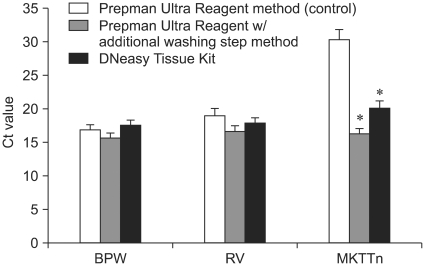1. Al-Soud WA, Ouis IS, Li DQ, Ljungh S, Wadström T. Characterization of the PCR inhibitory effect of bile to optimize real-time PCR detection of
Helicobacter species. FEMS Immunol Med Microbiol. 2005; 44:177–182. PMID:
15866213.
2. Bansal NS, Gray V, McDonell F. Validated PCR assay for the routine detection of
Salmonella in food. J Food Prot. 2006; 69:282–287. PMID:
16496566.
3. Catarame TMG, O'Hanlon KA, McDowell DA, Blair IS, Duffy G. Comparison of a real-time polymerase chain reaction assay with a culture method for the detection of Salmonella in retail meat samples. J Food Saf. 2006; 26:1–15.
4. Culp SJ, Beland FA, Heflich RH, Benson RW, Blankenship LR, Webb PJ, Mellick PW, Trotter RW, Shelton SD, Greenlees KJ, Manjanatha MG. Mutagenicity and carcinogenicity in relation to DNA adduct formation in rats fed leucomalachite green. Mutat Res. 2002; 506-507:55–63. PMID:
12351145.

5. Heller LC, Davis CR, Peak KK, Wingfield D, Cannons AC, Amuso PT, Cattani J. Comparison of methods for DNA isolation from food samples for detection of Shiga toxin-producing
Escherichia coli by real-time PCR. Appl Environ Microbiol. 2003; 69:1844–1846. PMID:
12620880.
6. Hughes D, Dailianis AE, Hill L, Curiale MS, Gangar V.
Salmonella in foods: new enrichment procedure for TECRA
Salmonella Visual Immunoassay using a single rv(R10) only, TT only, or dual rv(R10) and TT selective enrichment broths (AOAC official method 998.09): collaborative study. J AOAC Int. 2003; 86:775–790. PMID:
14509439.
7. Maher N, Dillon HK, Vermund SH, Unnasch TR. Magnetic bead capture eliminates PCR inhibitors in samples collected from the airborne environment, permitting detection of
Pneumocystis carinii DNA. Appl Environ Microbiol. 2001; 67:449–452. PMID:
11133478.
8. Malorny B, Hoorfar J. Toward standardization of diagnostic PCR testing of fecal samples: lessons from the detection of Salmonellae in pigs. J Clin Microbiol. 2005; 43:3033–3037. PMID:
16000411.

9. Malorny B, Paccassoni E, Fach P, Bunge C, Martin A, Helmuth R. Diagnostic real-time PCR for detection of
Salmonella in food. Appl Environ Microbiol. 2004; 70:7046–7052. PMID:
15574899.
10. Monteiro L, Bonnemaison D, Vekris A, Petry KG, Bonnet J, Vidal R, Cabrita J, Mégraud F. Complex polysaccharides as PCR inhibitors in feces:
Helicobacter pylori model. J Clin Microbiol. 1997; 35:995–998. PMID:
9157172.
11. Myint MS, Johnson YJ, Tablante NL, Heckert RA. The effect of pre-enrichment protocol on the sensitivity and specificity of PCR for detection of naturally contaminated
Salmonella in raw poultry compared to conventional culture. Food Microbiol. 2006; 23:599–604. PMID:
16943057.
12. Oliveira SD, Rodenbusch CR, Cé MC, Rocha SL, Canal CW. Evaluation of selective and non-selective enrichment PCR procedures for
Salmonella detection. Lett Appl Microbiol. 2003; 36:217–221. PMID:
12641714.
13. Rodríguez-Lázaro D, D'Agostino M, Pla M, Cook N. Construction strategy for an internal amplification control for real-time diagnostic assays using nucleic Acid sequence-based amplification: development and clinical application. J Clin Microbiol. 2004; 42:5832–5836. PMID:
15583319.

14. Rossen L, Nørskov P, Holmstrøm K, Rasmussen OF. Inhibition of PCR by components of food samples, microbial diagnostic assays and DNA-extraction solutions. Int J Food Microbiol. 1992; 17:37–45. PMID:
1476866.

15. Uyttendaele M, Vanwildemeersch K, Debevere J. Evaluation of real-time PCR vs automated ELISA and a conventional culture method using a semi-solid medium for detection of
Salmonella. Lett Appl Microbiol. 2003; 37:386–391. PMID:
14633109.
16. Uyttendaele MR, Debevere JM, Lips RM, Neyts KD. Prevalence of
Salmonella in poultry carcasses and their products in Belgium. Int J Food Microbiol. 1998; 40:1–8. PMID:
9600604.
17. Wiedbrauk DL, Werner JC, Drevon AM. Inhibition of PCR by aqueous and vitreous fluids. J Clin Microbiol. 1995; 33:2643–2646. PMID:
8567898.

18. Wilde J, Eiden J, Yolken R. Removal of inhibitory substances from human fecal specimens for detection of group A rotaviruses by reverse transcriptase and polymerase chain reactions. J Clin Microbiol. 1990; 28:1300–1307. PMID:
1696283.

19. Wilson IG. Inhibition and facilitation of nucleic acid amplification. Appl Environ Microbiol. 1997; 63:3741–3751. PMID:
9327537.








 PDF
PDF ePub
ePub Citation
Citation Print
Print




 XML Download
XML Download